
The Hawker Typhoon is a British single-seat fighter-bomber, produced by Hawker Aircraft and nicknamed "Bomphoon" by the press. It was intended to be a medium-high altitude interceptor, as a replacement for the Hawker Hurricane, but several design problems were encountered and it never completely satisfied this requirement.

The Hawker Tempest is a British fighter aircraft that was primarily used by the Royal Air Force (RAF) in the Second World War. The Tempest, originally known as the Typhoon II, was an improved derivative of the Hawker Typhoon, intended to address the Typhoon's unexpected deterioration in performance at high altitude by replacing its wing with a thinner laminar flow design. Since it had diverged considerably from the Typhoon, it was renamed Tempest. The Tempest emerged as one of the most powerful fighters of World War II and at low altitude was the fastest single-engine propeller-driven aircraft of the war.

La Caine is a commune in the Calvados department in the Normandy region in north-western France.
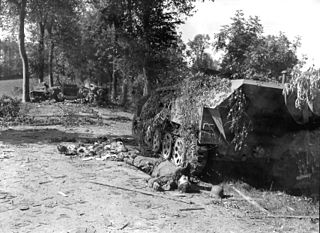
Operation Lüttich was the codename of the Nazi German counter-attack during the Battle of Normandy, which occurred near U.S. positions near Mortain, in northwestern France. Lüttich is the German name for the city of Liège, Belgium. In British and American histories of the Second World War, the German Operation Lüttich is known as the Mortain counter-attack, which Hitler ordered to regain territory gained by the First United States Army during Operation Cobra by reaching the coast of the Avranches region, which is at the base of the Cotentin peninsula, in order to isolate the units of the Third United States Army that had advanced into Brittany.
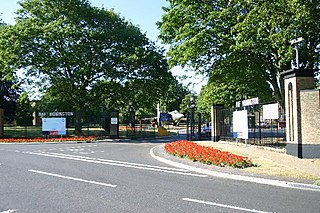
Royal Air Force Honington or more simply RAF Honington is a Royal Air Force station located 6 mi (9.7 km) south of Thetford near Ixworth in Suffolk, England. It was used as a bomber station during the Second World War and through the Cold War, hosting Handley Page Victors and Hawker Siddeley (Blackburn) Buccaneers. RAF Honington has been the RAF Regiment depot since 1994.

No. 2 Group is a group of the Royal Air Force which was first activated in 1918, served from 1918–20, from 1936 through the Second World War to 1947, from 1948 to 1958, from 1993 to 1996, was reactivated in 2000, and is today part of Air Command.
No. 143 Wing RCAF was a unit of the Royal Canadian Air Force which served with the Royal Air Force in Europe during the Second World War.
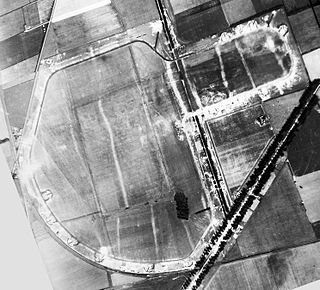
Royal Air Force Snailwell or more simply RAF Snailwell is a former Royal Air Force station located near to the village of Snailwell, Cambridgeshire, located 3 miles (4.8 km) north of Newmarket, Suffolk, England.

The RAF raid on La Caine (1944) was an attack on 10 June 1944 by aircraft of the Royal Air Force against the headquarters of Panzergruppe West during Operation Overlord the Allied invasion of France, which led the German Panzer divisions in France and Belgium. The headquarters had recently taken over the château at La Caine, about 12 mi (19 km) to the south-west of the city of Caen, north of Thury-Harcourt.
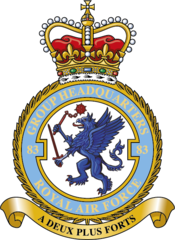
No. 83 Expeditionary Air Group is a group within the Royal Air Force, currently based at Al Udeid Air Base in Qatar.

The 350th Squadron is a fighter squadron in the Air Component of the Belgian Armed Forces. It was originally formed in 1941 as No. 350 (Belgian) Smaldeel of the Royal Air Force during World War II. The unit was transferred to the Belgian Air Force, together with 349th Squadron, in 1946. Based at Florennes air base, the unit is now part of the 2nd Tactical Wing and operates F-16 Fighting Falcons.
No. 198 Squadron was a Royal Air Force aircraft squadron that operated during the Second World War particularly in the ground attack role as the allies advanced through continental Europe.

Royal Air Force Matlaske or more simply RAF Matlaske is a former Royal Air Force satellite station to RAF Coltishall, situated near Matlaske in Norfolk, England.
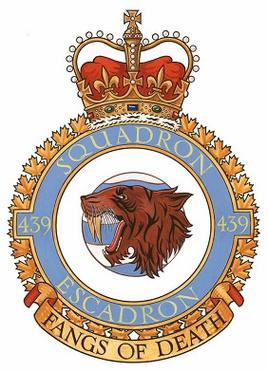
439 Combat Support Squadron is a squadron of the Royal Canadian Air Force, based in Bagotville, Quebec.
No. 146 Wing RAF was a formation of the Royal Air Force during the Second World War. It comprised No. 193 Squadron RAF, No. 197 Squadron RAF, No. 257 Squadron RAF, No. 263 Squadron RAF and No. 266 Squadron RAF.

Royal Air Force Needs Oar Point or more simply RAF Needs Oar Point is a former Royal Air Force advanced landing ground located near Lymington in Hampshire, England. Constructed in 1943 it was used from April 1944 as a base for Hawker Typhoon fighter-bomber squadrons of No. 146 Wing of the 2nd Tactical Air Force supporting the Normandy landings. All four operational squadrons moved to RAF Hurn for two weeks before moving on to France by July 1944 and the airfield was returned to agricultural use in 1945.

Royal Air Force New Romney or more simply RAF New Romney is a former Royal Air Force Advanced Landing Ground located 3.9 miles (6.3 km) north east of Lydd, Kent, England.
No. 135 Expeditionary Air Wing previously No. 135 Wing is a wing of the Royal Air Force. It was stationed at RAF Leeming, controlling the deployable subunits of the base. It was activated on 1 April 2006 as part of a modernisation package to make the RAF more deployable on an expeditionary basis.
No. 121 Expeditionary Air Wing is a deployable Expeditionary Air Wing of the Royal Air Force based at RAF Coningsby, Lincolnshire, England.














